Electrical Properties and Anisotropy of Schists and Fault Rocks from New Zealand’s Southern Alps under Confining Pressure
Abstract
:1. Introduction
2. Background
2.1. The Alpine Fault Zone
2.2. Electrical Current Transport in Rocks and Pore Fluids
2.3. Anisotropy of Electrical Properties and the Effect of Effective Confining Pressure
3. Materials and Methods
3.1. Sample Collection and Preparation
3.2. Anisotropy of Electrical Property Measurements
4. Results
4.1. Confining Pressure Experiments
4.2. Anisotropy of Electrical Properties
5. Discussion
5.1. Effect of Progressive Fabric Development on Resistivity and Porosity
5.2. Explanation for Anisotropy of Electrical Resistivity
5.3. Comparison with the Southern Alps Electrical Conductor
6. Conclusions
- There is a negative correlation between the resistivity and porosity of Alpine and Haast Schists; both are strongly associated with distance to the AFZ (Figure 6). We infer that the decrease in porosity and the increase in resistivity occurs during progressive development of a schistose tectonite fabric. The negative correlation of these two parameters indicates that the electrical properties of these rocks are dominated by charge transport in pore fluids.
- Alpine mylonite and ultramylonite samples exhibit low resistivity and low porosity relative to the schist samples. We hypothesize that a conductive process associated with progressive phase mixing and grain size reduction due to mylonitization supplements in pore fluid conduction in Alpine mylonites and ultramylonites. This could either be (i) conductance in linked solid phase networks, or (ii) effects along the EDL, such as surface conductivity, or a combination.
- This supplementary process increases mylonite sample conductivity to 1.7 times that of Alpine Schist samples in our laboratory measurements. Conversely, the SAEC is 1000 times more conductive than the surrounding crustal host rocks, at depths at which we expect confining pressures to significantly reduce pore fluid volumes. Therefore, we infer that the above supplementary processes, and perhaps others related to dynamic, temperature-sensitive creep, are also active within the SAEC. These remain to be explored in future studies
- The change in anisotropy of resistivity with increasing effective confining pressure (δ (ρ‖/ρ⊥)/δ (peff)) is lower for Alpine mylonite and ultramylonite than it is for Haast and Alpine Schists. We also attribute this to a decreased dependence on conductivity in fluids hosted in compliant porosity associated with progressive fabric development in these high strain, mylonitized rocks. The change in anisotropy varies since the schists have more anisotropic tectonite fabrics than the mylonites.
Author Contributions
Funding
Data Availability Statement
Acknowledgments
Conflicts of Interest
References
- Vanyan, L.L.; Shilovsky, A.P.; Okulessky, B.A.; Semenov, V.Y.; Sidelnikova, T.A. Electrical conductivity of the crust of the Siberian platform. Phys. Earth Planet. Inter. 1989, 54, 163–168. [Google Scholar] [CrossRef]
- Hyndman, R.; Vanyan, L.; Marquis, G.; Law, L. The origin of electrically conductive lower continental crust: Saline water or graphite? Phys. Earth Planet. Inter. 1993, 81, 325–345. [Google Scholar] [CrossRef]
- Hjelt, S. Regional EM studies in the 80′s. Surv. Geophys. 1988, 9, 349–387. [Google Scholar] [CrossRef]
- Jones, A. Electrical conductivity of the continental lower crust. In Continental Lower Crust; Fountain, D., Arculus, R., Kay, R., Eds.; Elsevier: Amsterdam, The Netherlands, 1992; pp. 81–143. [Google Scholar]
- Korja, T.; Hjelt, S. Electromagnetic studies in the Fennoscandian Shield—electrical conductivity of Precambrian crust. Phys. Earth Planet. Inter. 1993, 81, 107–138. [Google Scholar] [CrossRef]
- Leibecker, J.; Gatzemeier, A.; Hönig, M.; Kuras, O.; Soyer, W. Evidence of electrical anisotropic structures in the lower crust and the upper mantle beneath the Rhenish Shield. Earth Planet. Sci. Lett. 2002, 202, 289–302. [Google Scholar] [CrossRef]
- Yang, X. Origin of high electrical conductivity in the lower continental crust: A review. Surv. Geophys. 2011, 32, 875–903. [Google Scholar] [CrossRef]
- Vanyan, L.; Tezkan, B.; Palshin, N. Low electrical resistivity and seismic velocity at the base of the upper crust as indicator of rheologically weak layer. Surv. Geophys. 2001, 22, 131–154. [Google Scholar] [CrossRef]
- Haak, V.; Hutton, V.S. Electrical resistivity in continental lower crust. Geol. Soc. Lond. Spec. Publ. 1986, 24, 35–49. [Google Scholar] [CrossRef]
- Bahr, K.; Berktold, A.; Brink, H.; Haak, V.; Hofer, S.; Jiidicke, H.; Junge, A.; Junge, A.; Knddel, K.; Losecke, W.; et al. An electrical resistivity crustal section from the Alps to the Baltic Sea (central segment of the EGT). Tectonophysics 1992, 207, 123–139. [Google Scholar] [CrossRef]
- Olhoeft, G. Electrical Properties of Rocks. In Physical Properties of Rocks and Minerals, CINDAS Data Series on Material Properties; McGraw-Hill: New York, NY, USA, 1981; Volume II, pp. 262–278. [Google Scholar]
- Ucok, H. Temperature Dependence of the Electrical Resistivity of Aqueous Salt Solutions and Solution-Saturated Porous Rocks; University of Southern California: Los Angeles, CA, USA, 1979. [Google Scholar]
- Wannamaker, P.; Jiracek, G.; Stodt, J.; Caldwell, T.; Gonzalez, V.; Mcknight, J.; Porter, A. Fluid generation and pathways beneath an active compressional orogen, the New Zealand Southern Alps, inferred from magnetotelluric data. J. Geophys. Res. 2002, 107, 2117. [Google Scholar] [CrossRef] [Green Version]
- Li, S.; Unsworth, M.; Booker, J.; Wei, W.; Tan, H.; Jones, A. Partial melt or aqueous fluid in the mid-crust of Southern Tibet? Constraints from INDEPTH magnetotelluric data. Geophys. J. Int. 2003, 153, 289–304. [Google Scholar] [CrossRef] [Green Version]
- Hermance, F. The electrical conductivity of materials containing partial melt: A simple model from Archie’s Law. Geophys. Res. Lett. 1979, 6, 613–616. [Google Scholar] [CrossRef]
- Frost, B.; Fyfe, W.; Tazaki, K.; Chan, T. Grain-boundary graphite in rocks and implications for high electrical conductivity in the lower crust. Nature 1989, 340, 134–136. [Google Scholar] [CrossRef]
- Shankland, T.; Duba, A.; Mathez, E.; Peach, C. Increase of electrical conductivity with pressure as an indicator of conduction through a solid phase in midcrustal rocks. J. Geophys. Res. 1997, 102, 14741–14750. [Google Scholar] [CrossRef] [Green Version]
- Watson, H.; Roberts, J.; Tyburczy, J. Effect of conductive impurities on electrical conductivity in polycrystalline olivine. Geophys. Res. Lett. 2010, 37, L02302. [Google Scholar] [CrossRef]
- Jiracek, G.; Gonzalez, V.; Caldwell, T.; Wannamaker, P.; Kilb, D. Seismogenic, Electrically Conductive, and Fluid Zones at Continental Plate Boundaries in New Zealand, Himalaya, and California. Geophys. Monogr. Ser. 2007, 175, 347. [Google Scholar] [CrossRef]
- Christensen, N.; Okaya, D. Compressional and shear wave velocities in South Island, New Zealand rocks and their application to the interpretation of seismological models of the New Zealand crust. Geophys. Monogr. Ser. 2007, 175, 123–155. [Google Scholar] [CrossRef]
- Norris, R.; Cooper, A. The Alpine Fault, New Zealand: Surface geology and field relationships. Geophys. Monogr. Ser. 2007, 175, 157–175. [Google Scholar] [CrossRef]
- Menzies, C.; Teagle, D.; Niedermann, S.; Cox, S.; Craw, D.; Zimmer, M.; Cooper, M.; Erzinger, J. The fluid budget of a continental plate boundary fault: Quantification from the Alpine Fault, New Zealand. Earth Planet. Sci. Lett. 2016, 445, 125–136. [Google Scholar] [CrossRef] [Green Version]
- Greenroyd, C.; Yu, J.; Melhuish, A.; Ravens, J.; Davey, F.; Maslen, G.; SIGHT Working Group. New Zealand South Island Geophysical Transect (SIGHT): Marine Active-Source Seismic Component—A Processing Summary; Science Report; Institute of Geological & Nuclear Sciences: Lower Hutt, New Zealand, 2003; Volume 20. [Google Scholar]
- Van Avendonk, H.; Holbrook, S.; Okaya, D.; Austin, J.; Davey, F.; Stern, T. Continental crust under compression: A seismic refraction study of South Island Geophysical Transect I, South Island, New Zealand. J. Geophys. Res. Solid Earth 2004, 109, B06302. [Google Scholar] [CrossRef]
- Dempsey, E.; Prior, D.; Mariani, E.; Toy, V.; Tatham, D. Mica-controlled anisotropy within mid-to-upper crustal mylonites: An EBSD study of mica fabrics in the Alpine Fault Zone, New Zealand. Geol. Soc. Lond. Spec. Publ. 2011, 360, 33–47. [Google Scholar] [CrossRef]
- Adam, L.; Frehner, M.; Sauer, K.; Toy, V.; Guerin-Marthe, S. Seismic anisotropy and its impact on imaging the shallow Alpine Fault: An experimental and modeling perspective. J. Geophys. Res. Solid Earth 2020, 125, e2019JB019029. [Google Scholar] [CrossRef]
- Cox, S.; Menzies, C.; Sutherland, R.; Denys, P.; Chamberlain, C.; Teagle, D. Changes in hot spring temperature and hydrogeology of the Alpine Fault hanging wall, New Zealand, induced by distal South Island earthquakes. Geofluids 2015, 15, 216–239. [Google Scholar] [CrossRef] [Green Version]
- Cooper, A.; Palin, J.M. Two-sided accretion and polyphase metamorphism in the Haast Schist belt, New Zealand: Constraints from detrial zircon geochronology. Geol. Soc. Am. Bull. 2018, 130, 1501–1518. [Google Scholar] [CrossRef]
- Norris, R.; Cooper, A. Late Quaternary slip rates and slip partitioning on the Alpine Fault, New Zealand. J. Struct. Geol. 2001, 23, 507–520. [Google Scholar] [CrossRef]
- Jacobson, A.; Blum, J.; Chamberlain, C.; Craw, D.; Koons, P. Climatic and tectonic controls on chemical weathering in the New Zealand Southern Alps. Geochim. Cosmochim. Acta 2003, 67, 29–46. [Google Scholar] [CrossRef]
- Ingham, M. Electrical structure along a transect of the central South Island, New Zealand. N. Z. J. Geol. Geophys. 1995, 38, 559–563. [Google Scholar] [CrossRef]
- Ingham, M. Magnetotelluric soundings across the Southern Alps orogen, South Island of New Zealand: Data presentation and preliminary interpretation. Phys. Earth Planet. Inter. 1996, 94, 291–306. [Google Scholar] [CrossRef]
- Haak, V.; Stoll, J.; Winter, H. Why is the electrical resistivity around the KTB hole so low? Phys. Earth Planet. Inter. 1991, 66, 12–23. [Google Scholar] [CrossRef]
- Lemonnier, C.; Marquis, G.; Perrier, F.; Avouac, J.-P.; Chitrakar, G.; Kafle, B.; Sapkota, S.; Gautam, U.; Tiwari, D.; Bano, M. Electrical structure of the Himalaya of Central Nepal: High conductivity around the mid-crustal ramp along the MHT. Geophys. Res. Lett. 1999, 26, 3261–3264. [Google Scholar] [CrossRef] [Green Version]
- Uyeshima, M.; Ogawa, Y.; Honkura, Y.; Koyama, S.; Ujihara, N.; Mogi, T.; Yamaya, Y.; Harada, M.; Yamaguchi, S.; Shiozaki, I.; et al. Resistivity imaging across the source region of the 2004 Mid-Niigata Prefecture earthquake (M6.8), central Japan. Earth Planets Space 2005, 57, 441–446. [Google Scholar] [CrossRef] [Green Version]
- Bailey, R. Trapping of aqueous fluids in the deep crust. Geophys. Res. Lett. 1990, 17, 1129–1132. [Google Scholar] [CrossRef]
- Watson, E.; Brenan, J. Fluids in the lithosphere, 1. Experimentally-determined wetting characteristics of CO2-H2O fluids and their implications for fluid transport, host-rock physical properties, and fluid inclusion formation. Earth Planet. Sci. Lett. 1987, 85, 497–515. [Google Scholar] [CrossRef]
- Yardley, B.W.D.; Valley, J.W. The petrologic case for a dry lower crust. J. Geophys. Res. Solid Earth 1997, 102, 12173–12185. [Google Scholar] [CrossRef]
- Little, T.; Cox, S.; Vry, J.; Batt, G. Variations in exhumation level and uplift rate along the oblique-slip Alpine Fault, Central Southern Alps, New Zealand. Geol. Soc. Am. Bull. 2005, 117, 707–723. [Google Scholar] [CrossRef]
- Sutherland, R.; Townend, J.; Toy, V.; Upton, P.; Coussens, J.; Allen, M.; Baratin, L.-M.; Barth, N.; Becroft, L.; Boese, C.; et al. Extreme hydrothermal conditions at an active plate-bounding fault. Nature 2017, 546, 137–140. [Google Scholar] [CrossRef] [Green Version]
- Norris, R.; Cooper, A. Very high strains recorded in mylonites along the Alpine Fault, New Zealand: Implications for the deep structure of plate boundary faults. J. Struct. Geol. 2003, 25, 2141–2157. [Google Scholar] [CrossRef]
- Walcott, R. Present tectonics and Late Cenozoic evolution of New Zealand. Geophys. J. Int. 1978, 52, 137–164. [Google Scholar] [CrossRef] [Green Version]
- Norris, R. A geometrical study of finite strain and bending in the South Island. J. R. Soc. N. Z. 1979, 18, 21–28. [Google Scholar]
- Mortimer, N. Metamorphic discontinuities in orogenic belts: Example of the garnet-biotite-albite zone in the Otago Schist, New Zealand. Int. J. Earth Sci. 2000, 89, 295–306. [Google Scholar] [CrossRef]
- Toy, V.; Boulton, C.; Sutherland, R.; Townend, J.; Norris, R.J.; Little, T.A.; Prior, D.G.; Mariani, E.; Faulkner, D.; Menzies, C.D.; et al. Fault rock lithologies and architecture of the central Alpine Fault, New Zealand, revealed by DFDP-1 drilling. Lithosphere 2015, 7, 155–173. [Google Scholar] [CrossRef] [Green Version]
- Sutherland, R.S.; Townend, J.; Toy, V.G. Deep Fault Drilling Project (DFDP), Alpine Fault Boreholes DFDP-2A and DFDP-2B Technical Completion Report; GNS Science Report; DFDP-2 Science Party: Lower Hutt, New Zealand, 2015; Volume 50. [Google Scholar]
- Toy, V.; Sutherland, R.; Townend, J.; Allen, M.J.; Becroft, L.; Boles, A.; Boulton, C.; Carpenter, B.; Cooper, A.; Cox, S.C.; et al. Bedrock geology of DFDP-2B, central Alpine Fault, New Zealand. N. Z. J. Geol. Geophys. 2017, 60, 497–518. [Google Scholar] [CrossRef] [Green Version]
- Koons, P. Some thermal and mechanical consequences of rapid uplift: An example from the Southern Alps, New Zealand. Earth Planet. Sci. Lett. 1987, 86, 307–319. [Google Scholar] [CrossRef]
- Little, T.; Holcombe, R.; Ilg, B. Ductile fabrics in the zone of active oblique convergence near the Alpine Fault, New Zealand: Identifying the neotectonic overprint. J. Struct. Geol. 2002, 24, 193–217. [Google Scholar] [CrossRef]
- Massiot, C.; Célérier, B.; Doan, M.-L.; Little, T.A.; Townend, J.; McNamara, D.D.; Williams, J.; Schmitt, D.R.; Toy, V.G.; Sutherland, R.; et al. The Alpine Fault hanging wall viewed from within: Structural analysis of ultrasonic image logs in the DFDP-2B Borehole, New Zealand. Geochem. Geophys. Geosyst. 2018, 19, 2492–2515. [Google Scholar] [CrossRef] [Green Version]
- Billia, M.; Timms, N.; Toy, V.; Hart, R.; Prior, D. Grain boundary dissolution porosity in quartzofeldspathic ultramylonites: Implications for permeability enhancement and weakening of mid-crustal shear zones. J. Struct. Geol. 2013, 53, 2–14. [Google Scholar] [CrossRef]
- Fusseis, F.; Regenauer-Lieb, K.; Liu, J.; Hough, R.; Carlo, F. Creep cavitation can establish a dynamic granular fluid pump in ductile shear zones. Nature 2009, 459, 974–977. [Google Scholar] [CrossRef]
- Olhoeft, G. Electrical properties, initial reports on the Petrophysics laboratory. U.S. Geol. Surv. Circ. 1979, 789, 1–25. [Google Scholar]
- Revil, A.; Cathles, L.; Losh, S.; Nunn, J. Electrical conductivity in shaly sands with geophysical applications. J. Geophys. Res. 1998, 103, 23925–23936. [Google Scholar] [CrossRef]
- Revil, A.; Glover, P. Theory of ionic-surface electrical conduction in porous media. Phys. Rev. B 1997, 55, 1757–1773. [Google Scholar] [CrossRef] [Green Version]
- Revil, A.; Coperey, A.; Shao, Z.; Florsch, N.; Fabricius, I.L.; Deng, Y.; Delsman, J.R.; Pauw, P.S.; Karaoulis, M.; De Louw, P.G.B.; et al. Complex conductivity of soils. Water Resour. Res. 2017, 53, 7121–7147. [Google Scholar] [CrossRef] [Green Version]
- Archie, G. The Electrical Resistivity Log as an Aid in Determining Some Reservoir Characteristics. Trans. AIME 1942, 146, 54–62. [Google Scholar] [CrossRef]
- Siegesmund, S.; Vollbrecht, A.; Nover, G. Anisotropy of compressional wave velocities, complex electrical resistivity and magnetic susceptibility of mylonites from the deeper crust and their relation to the rock fabric. Earth Planet. Sci. Lett. 1991, 105, 247–259. [Google Scholar] [CrossRef]
- Zisser, N.; Nover, G. Anisotropy of permeability and complex resistivity of tight sand-stones subjected to hydrostatic pressure. J. Appl. Geophys. 2009, 68, 356–370. [Google Scholar] [CrossRef]
- Brace, W.F. Permeability from resistivity and pore shape. J. Geophys. Res. 1977, 82, 3343–3349. [Google Scholar] [CrossRef]
- Lockner, D.; Byerlee, J. Complex resistivity measurements of confined rock. J. Geophys. Res. 1985, 90, 7837–7848. [Google Scholar] [CrossRef]
- Toy, V.G. Rheology of the Alpine Fault Mylonite Zone: Deformation Processes at and below the Base of the Seismogenic Zone in a Major Plate Boundary Shear Zone. Ph.D. Thesis, University of Otago, Dunedin, New Zealand, 2008; 629p. [Google Scholar]
- Kirilova, M.; Toy, V.G.; Timms, N.; Halfpenny, A.; Menzies, C.; Craw, D.; Beyssac, O.; Sutherland, R.; Townend, J.; Boulton, C.; et al. Textural changes of graphitic carbon by tectonic and hydrothermal processes in an active plate boundary fault zone, Alpine Fault, New Zealand. Geol. Soc. Lond. Spec. Publ. 2018, 453, 205–223. [Google Scholar] [CrossRef] [Green Version]
- Saltas, V.; Pentari, D.; Vallianatos, F. Complex electrical conductivity of biotite and muscovite micas at elevated temperatures: A comparative study. Materials 2021, 13, 3513. [Google Scholar] [CrossRef]
- Kaselow, A.; Shapiro, S. Stress sensitivity of elastic moduli and electrical resistivity in porous rocks. J. Geophys. Eng. 2004, 1, 1. [Google Scholar] [CrossRef]
- Dobe, R.; Das, A.; Mukherjee, R.; Gupta, S. Evaluation of grain boundaries as percolation pathways in quartz-rich continental crust using Atomic Force Microscopy. Sci. Rep. 2021, 11, 9831. [Google Scholar] [CrossRef]
- Morrow, C.; Lockner, D.A.; Hickman, S. Low resistivity and permeability in actively deforming shear zones on the San Andreas Fault at SAFOD. J. Geophys. Res. 2015, 120, 8240–8258. [Google Scholar] [CrossRef]
- Norris, R.J.; Bishop, D.G. Deformed conglomerates and textural zones in the Otago Schists, South Island, New Zealand. Tectonophysics 1990, 174, 331–349. [Google Scholar] [CrossRef]
- Hay, R.; Evans, B. Intergranular distribution of pore fluid and the nature of high-angle grain boundaries in limestone and marble. J. Geophys. Res. 1988, 93, 8959–8974. [Google Scholar] [CrossRef]
- Ji, S.; Wang, Q.; Marcotte, D.; Salisbury, M.H.; Xu, Z. P wave velocities, anisotropy and hysteresis in ultrahigh-pressure metamorphic rocks as a function of confining pressure. J. Geophys. Res. Solid Earth 2007, 112, B09204. [Google Scholar] [CrossRef] [Green Version]
- Brace, W.F. Some new measurements of linear compressibility of rocks. J. Geophys. Res. 1965, 70, 391–398. [Google Scholar] [CrossRef]
- Birch, F. The velocity of compressional waves in rocks to 10 kilobars: 2. J. Geophys. Res. 1961, 66, 2199–2224. [Google Scholar] [CrossRef]
- Kern, H.; Wenk, H.-R. Fabric-related velocity anisotropy and shear wave splitting in rocks from Santa Rosa Mylonite Zone, California. J. Geophys. Res. 1990, 95, 11213–11223. [Google Scholar] [CrossRef]
- Ivankina, T.; Kern, H.; Nikitin, A. Directional dependence of P- and S-wave propagation and polarization in foliated rocks from the Kola superdeep well: Evidence from laboratory measurements and calculations based on TOF neutron diffraction. Tectonophysics 2005, 407, 25–42. [Google Scholar] [CrossRef]
- Burlini, L.; Kunze, K. Fabric and seismic properties of Carrara marble mylonite. Phys. Chem. Earth Part A Solid Earth Geod. 2000, 25, 133–139. [Google Scholar] [CrossRef]
- Jones, T.; Nur, A. Seismic velocity and anisotropy in mylonites and the reflectivity of deep crystal fault zones. Geology 1982, 10, 260–263. [Google Scholar] [CrossRef]
- Garboczi, E.; Snyder, K.; Douglas, J.; Thorpe, M.F. Geometrical percolation threshold of overlapping ellipsoids. Phys. Rev. E 1995, 52, 819–828. [Google Scholar] [CrossRef] [PubMed] [Green Version]
- Gueguen, Y.; Dienes, J. Transport properties of rock from statistics and percolation. Math. Geol. 1989, 21, 1–13. [Google Scholar] [CrossRef]
- Sarout, J. Impact of pore space topology on permeability, cut-off frequencies and validity of wave propagation theories. Geophys. J. Int. 2012, 189, 481–492. [Google Scholar] [CrossRef] [Green Version]
- Sarout, J.; Cazes, E.; Delle Piane, C.; Arena, A.; Esteban, L. Stress-dependent permeability and wave dispersion in tight cracked rocks: Experimental validation of simple effective medium models. J. Geophys. Res. Solid Earth 2017, 122, 6180–6201. [Google Scholar] [CrossRef]
- Tsuji, T.; Iturrino, G. Velocity-porosity relationships in oceanic basalt from eastern flank of the Juan de Fuca Ridge: The effect of crack closure on seismic velocity. Explor. Geophys. 2008, 39, 41–51. [Google Scholar] [CrossRef]
- Charoensawan, J.; Adam, L.; Ofman, M.; Toy, V.; Simpson, J.; Zhong, X.; Schuck, B. Fracture shape and orientation contributions to P-wave velocity and anisotropy of Alpine Fault Mylonites. Front. Earth Sci. 2021, 9, 238. [Google Scholar] [CrossRef]
- Bahr, K. Electrical anisotropy and conductivity distribution functions of fractal random networks and of the crust: The scale effect of connectivity. Geophys. J. Int. 1997, 130, 649–660. [Google Scholar] [CrossRef]
- Guéguen, Y.; Gavrilenk, P.; Le Ravalec, M. Scales of rock permeability. Surv. Geophys. 1996, 17, 245–263. [Google Scholar] [CrossRef]
- Hsieh, P.; Shapiro, A.; Goode, D.; Tiedeman, C. Hydraulic Conductivity of Fractured Crystalline Rocks from Meter to Kilometer Scale: Observations from the Mirror Lake Site. In Proceedings of the New Hampshire Conference, Lincoln, NH, USA, 6–9 June 1994. [Google Scholar]
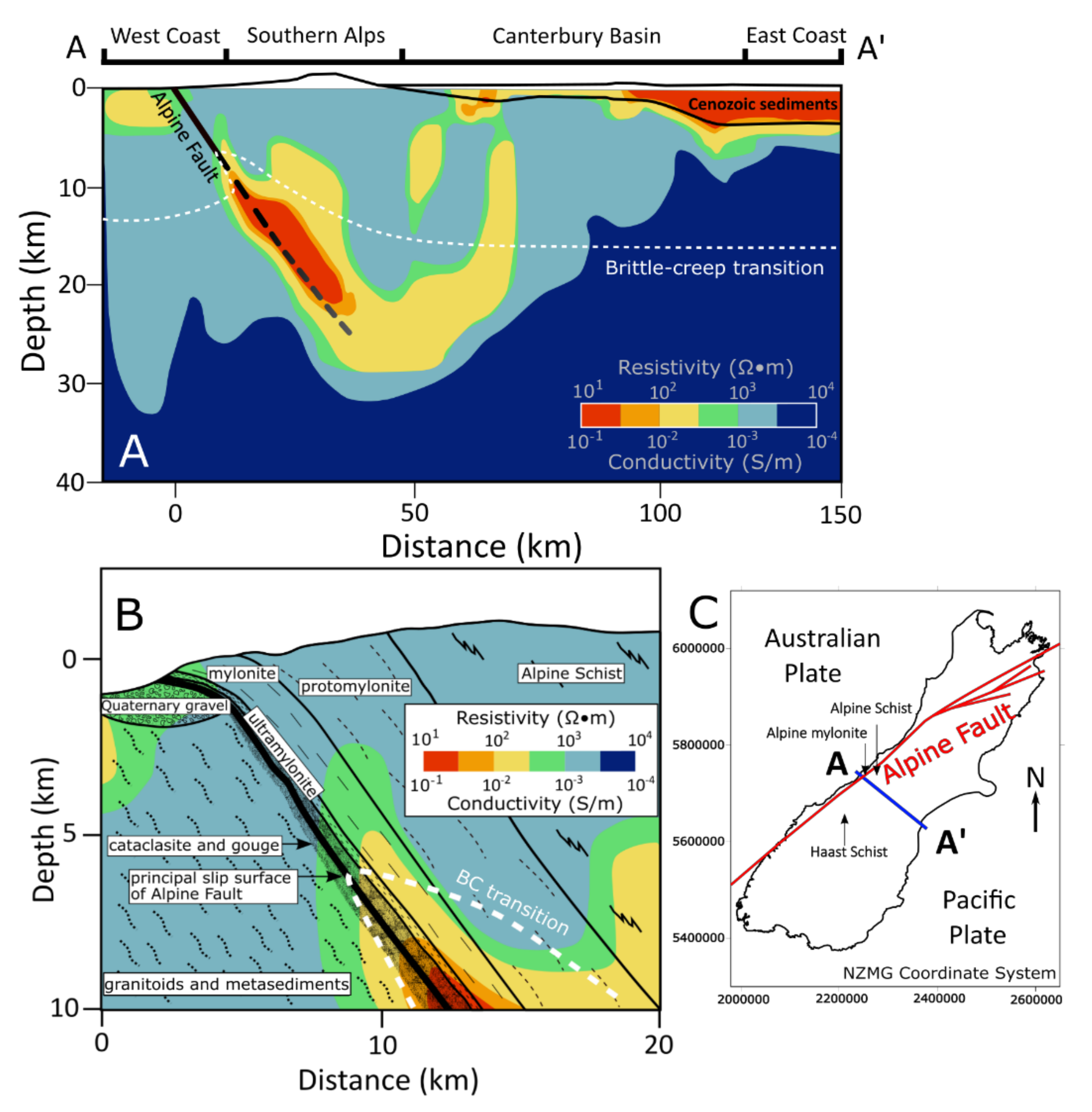
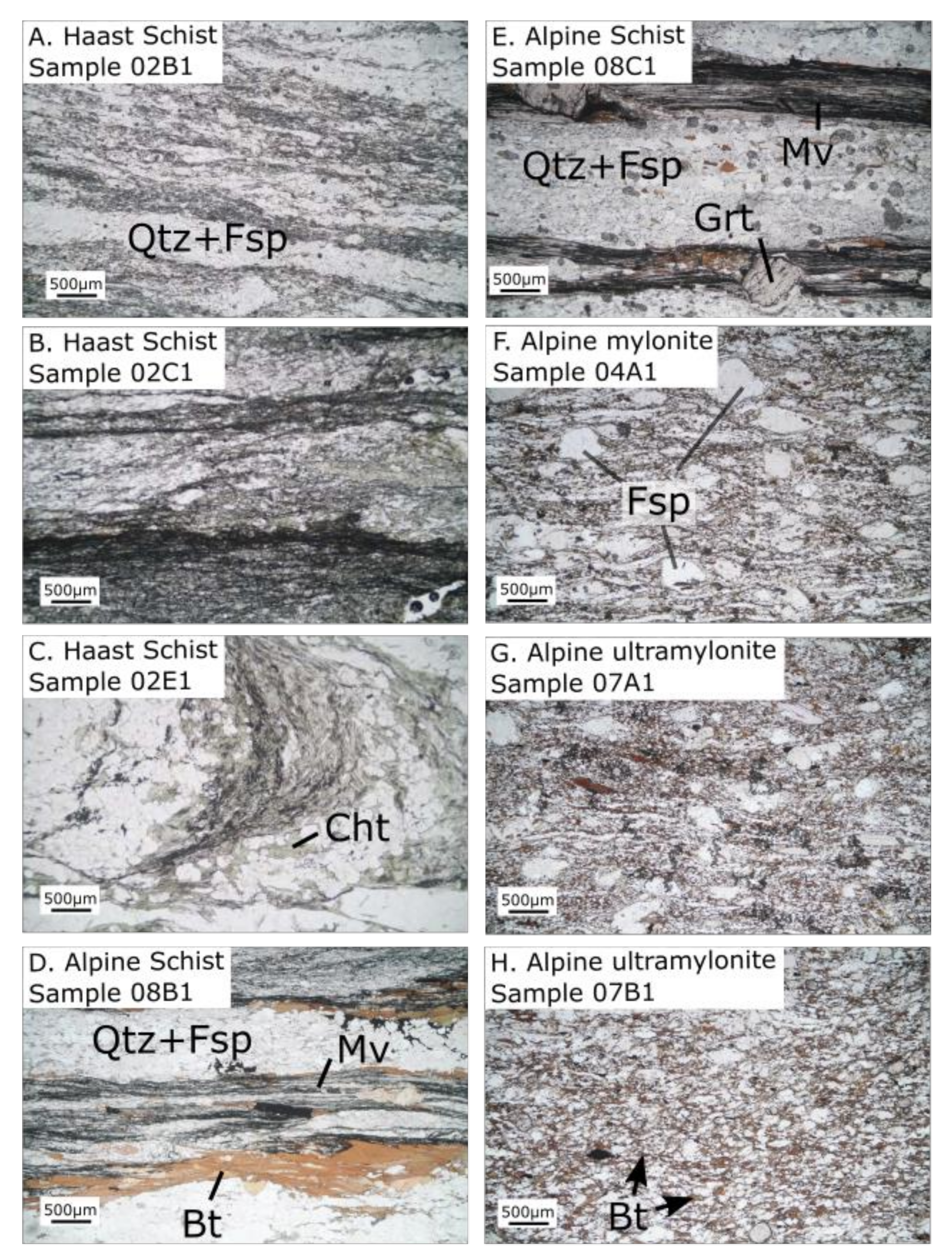

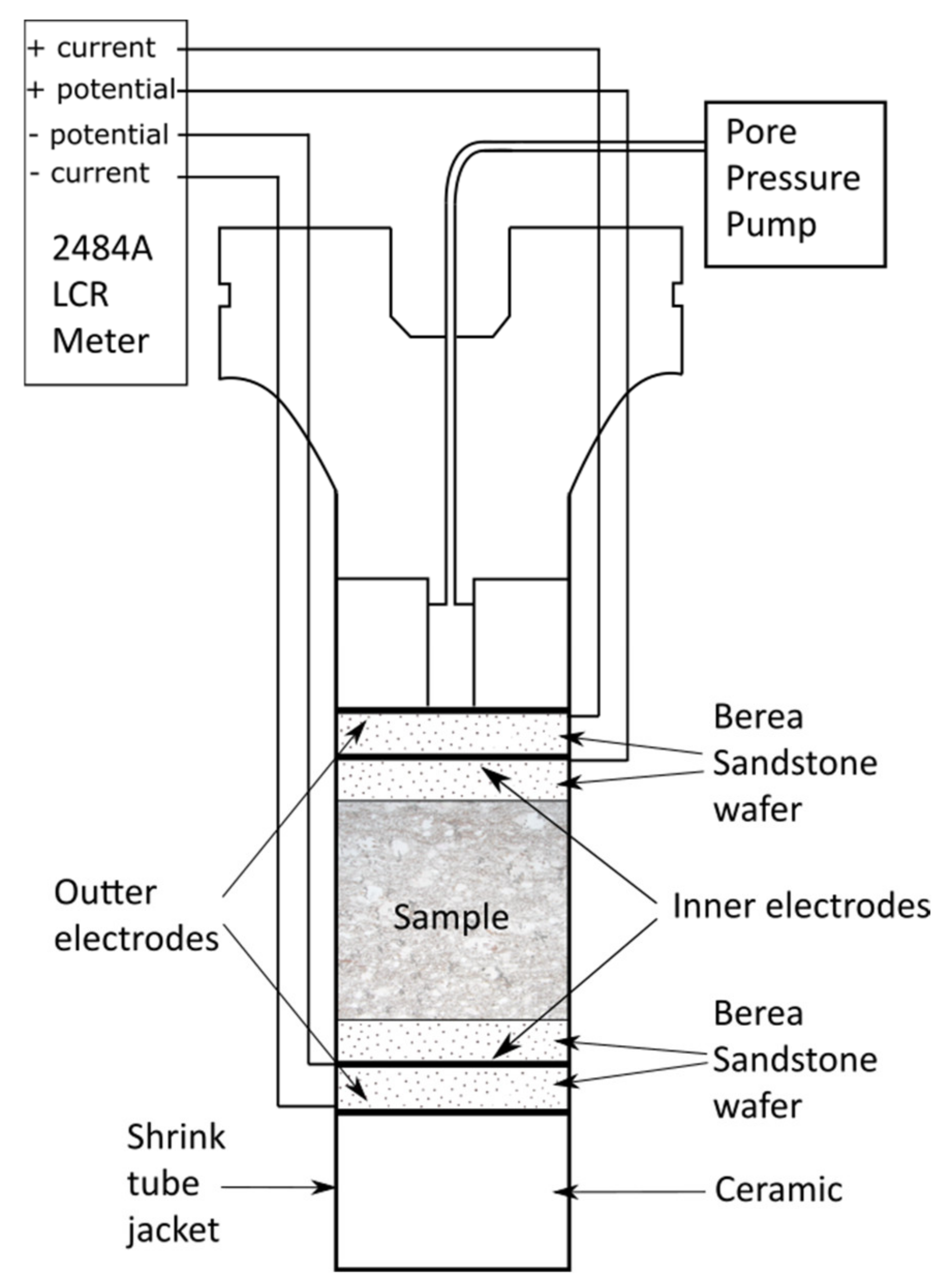
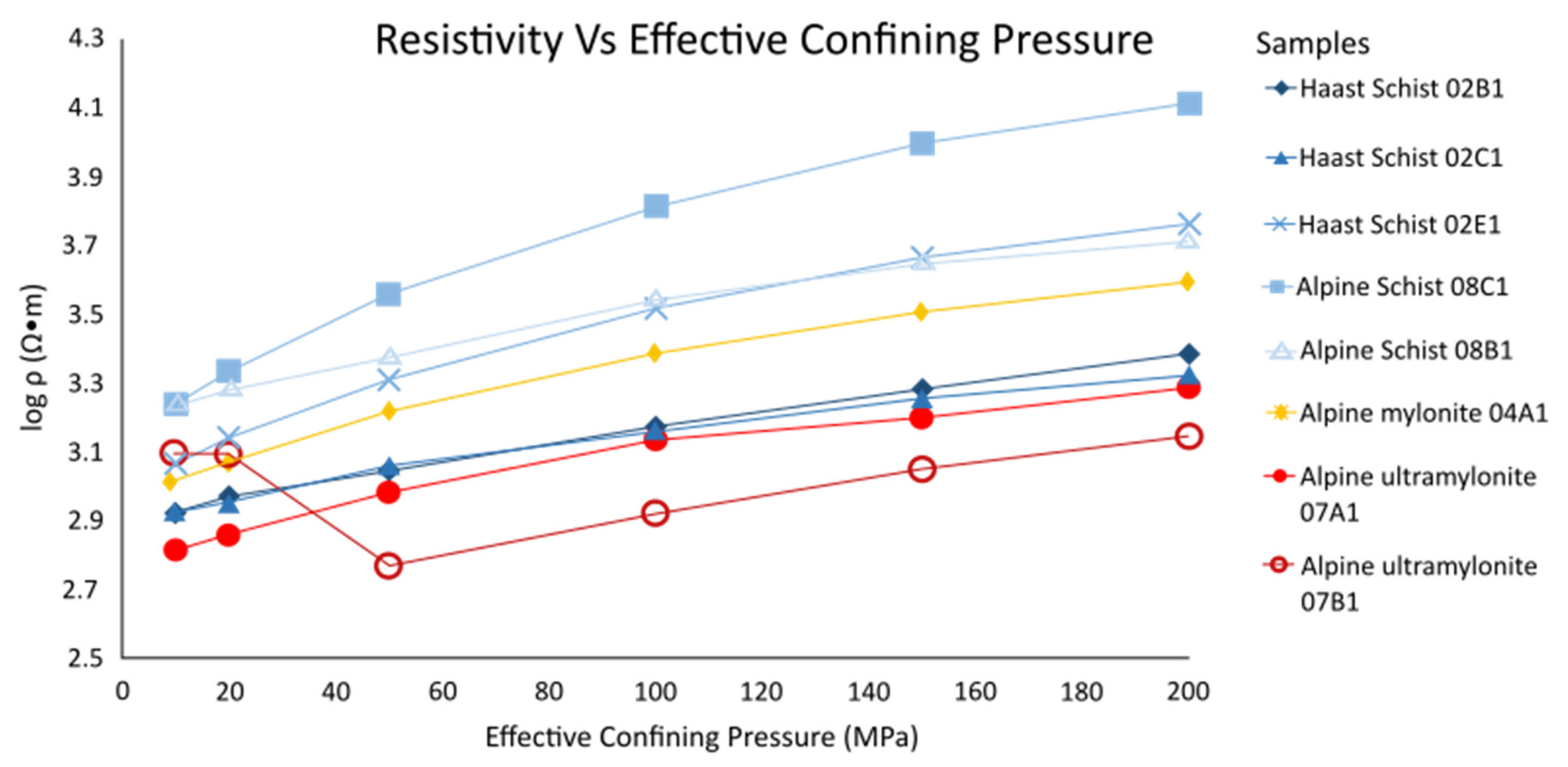

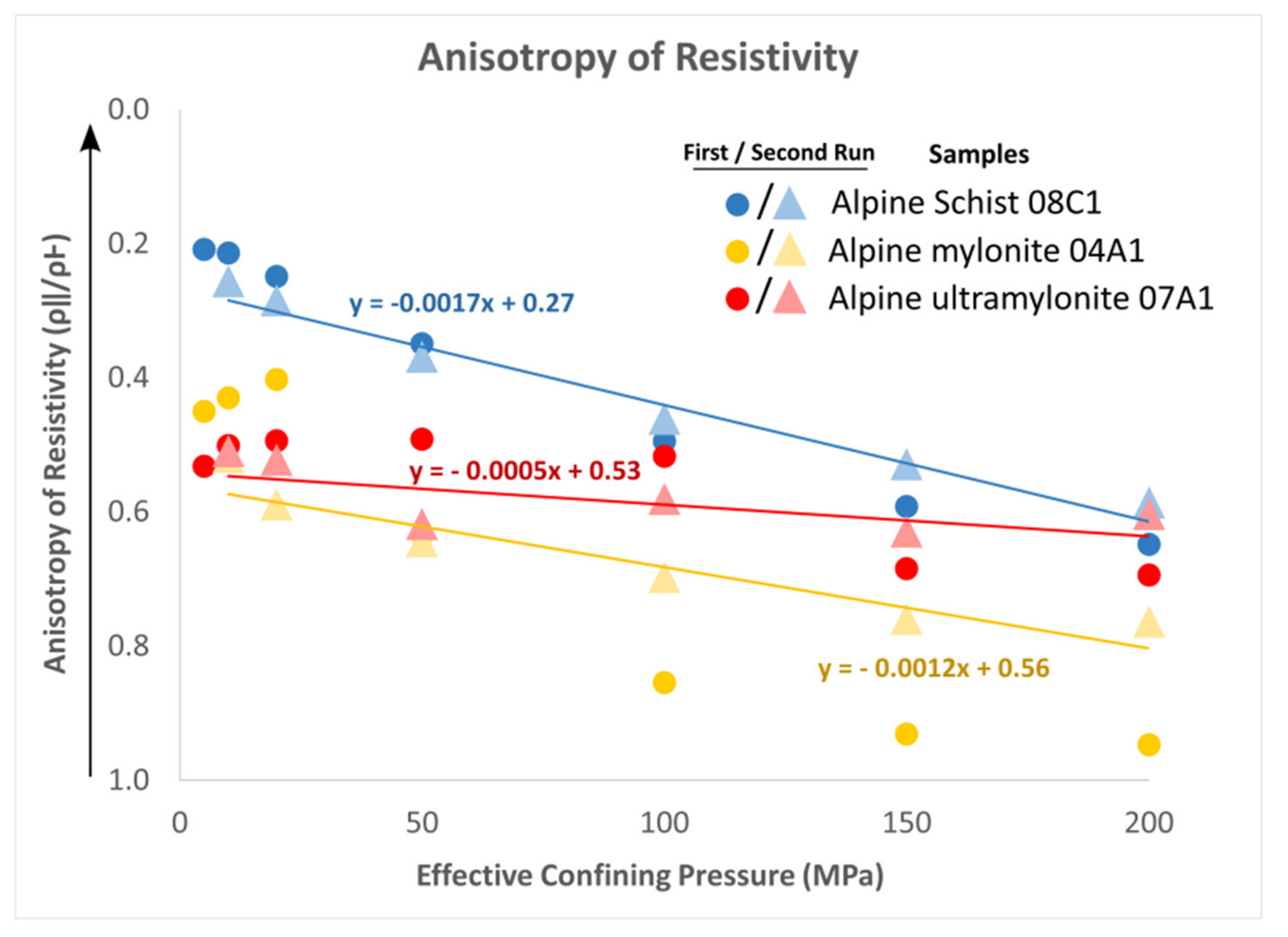

| Haast Schist | Alpine Schist | Alpine Mylonite | Alpine Ultramylonite | |||||||||
|---|---|---|---|---|---|---|---|---|---|---|---|---|
| 02B1 | 02C1 | 02E1 | 08B1 | 08C1 | 08C1 * | 04A1 | 04A1 * | 07A1 | 07A1 * | 07B1 | ||
| Φ | 0.054 | 0.039 | 0.021 | 0.018 | 0.012 | 0.012 | 0.015 | 0.015 | 0.018 | 0.018 | 0.010 | |
| Distance to AFZ (km) | 13.5 | 12.0 | 10.5 | 3.4 | 2.8 | 2.8 | 0.40 | 0.40 | 0.15 | 0.15 | 0.12 | |
| peff (MPa) | ||||||||||||
| First Run | 5 | 449 | 506 | 617 | 1370 | 286 | 1100 | 757 | 386 | 552 | 294 | 231 |
| 10 | 495 | 560 | 758 | 1640 | 351 | 1320 | 981 | 485 | 644 | 323 | 270 | |
| 20 | 567 | 671 | 1040 | 1880 | 468 | 1730 | 1330 | 653 | 785 | 388 | 329 | |
| 50 | 733 | 908 | 1740 | 2390 | 835 | 2960 | 1330 | 1010 | 1020 | 502 | 466 | |
| 100 | 1160 | 1230 | 2590 | 3090 | 1530 | 5100 | 1790 | 1550 | 1380 | 714 | 717 | |
| 150 | 1470 | 1650 | 3810 | 3730 | 2210 | 8510 | 2320 | 2000 | 1810 | 1240 | 977 | |
| 200 | 1970 | 1980 | 5010 | 4330 | 2810 | 11,600 | 2840 | 2470 | 2290 | 1590 | 1250 | |
| Second Run | 10 | 837 | 844 | 1150 | 1780 | 468 | 1730 | 1020 | 593 | 875 | 452 | 1250 |
| 20 | 941 | 900 | 1390 | 1910 | 556 | 2160 | 1150 | 746 | 963 | 510 | 1250 | |
| 50 | 1110 | 1150 | 2040 | 2390 | 898 | 3610 | 1660 | 1160 | 1200 | 750 | 588 | |
| 100 | 1490 | 1430 | 3290 | 3480 | 1630 | 6480 | 2430 | 1760 | 1890 | 1110 | 831 | |
| 150 | 1910 | 1810 | 4620 | 4480 | 2400 | 9920 | 3210 | 2380 | 2310 | 1470 | 1120 | |
| 200 | 2430 | 2100 | 5790 | 5160 | 3060 | 12,900 | 3960 | 2870 | 2820 | 1720 | 1400 | |
Publisher’s Note: MDPI stays neutral with regard to jurisdictional claims in published maps and institutional affiliations. |
© 2022 by the authors. Licensee MDPI, Basel, Switzerland. This article is an open access article distributed under the terms and conditions of the Creative Commons Attribution (CC BY) license (https://creativecommons.org/licenses/by/4.0/).
Share and Cite
Kluge, E.-K.; Toy, V.; Lockner, D. Electrical Properties and Anisotropy of Schists and Fault Rocks from New Zealand’s Southern Alps under Confining Pressure. Geosciences 2022, 12, 121. https://doi.org/10.3390/geosciences12030121
Kluge E-K, Toy V, Lockner D. Electrical Properties and Anisotropy of Schists and Fault Rocks from New Zealand’s Southern Alps under Confining Pressure. Geosciences. 2022; 12(3):121. https://doi.org/10.3390/geosciences12030121
Chicago/Turabian StyleKluge, Emma-Katherine, Virginia Toy, and David Lockner. 2022. "Electrical Properties and Anisotropy of Schists and Fault Rocks from New Zealand’s Southern Alps under Confining Pressure" Geosciences 12, no. 3: 121. https://doi.org/10.3390/geosciences12030121
APA StyleKluge, E.-K., Toy, V., & Lockner, D. (2022). Electrical Properties and Anisotropy of Schists and Fault Rocks from New Zealand’s Southern Alps under Confining Pressure. Geosciences, 12(3), 121. https://doi.org/10.3390/geosciences12030121






